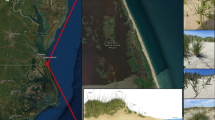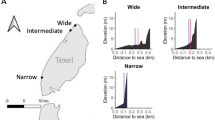Abstract
Barrier islands are at the forefront of storms and sea-level rise. High disturbance regimes and sediment mobility make these systems sensitive and dynamic. Island foredunes are protective structures against storm-induced overwash that are integrally tied to dune grasses via biogeomorphic feedbacks. Shifts in dune grass dominance could influence dune morphology and susceptibility to overwash, altering island stability. In a glasshouse study, two dune grasses, Ammophila breviligulata and Uniola paniculata, were planted together and subjected to a 20 cm burial to quantify morphological and physiological responses. Burial had positive effects on both plants as indicated by increased electron transport rate and total biomass. Ammophila breviligulata performance declined when planted with U. paniculata. Uniola paniculata was not affected when planted with A. breviligulata but did have higher water use efficiency and nitrogen use efficiency. Planted in mixture, differential reallocation of biomass occurred between species potentially altering resource acquisition further. As U. paniculata migrates into A. breviligulata dominated habitat and A. breviligulata performance diminishes, biotic interactions between these and other species may affect dune formation and community structure. Our study emphasizes the importance of studying biotic interactions alongside naturally occurring abiotic drivers.




Similar content being viewed by others
References
Brantley ST, Bissett SN, Young DR, Wolner CWV, Moore LJ (2014) Barrier island morphology and sediment characteristics affect the recovery of dune building grasses following storm-induced overwash. PLoS ONE 9:e104747
Charbonneau BR, Wnek JP, Langley JA, Lee G, Balsamo RA (2016) Aboveground vs. belowground plant biomass along a barrier island: implications for dune stabilization. J Environ Manage 182:126–133
Dilustro JJ, Day FP (1997) Aboveground biomass and net primary production along a Virginia barrier island chronosequence. Am Midl Nat 137:27–38
Disraeli DJ (1984) The effect of sand deposits on the growth and morphology of Ammophila breviligulata. J Ecol 72:145–154
Dolan R (1972) Barrier dune system along the Outer Banks of North Carolina: a reappraisal. Science 176:286–288
Durán O, Moore LJ (2013) Vegetation controls on the maximum size of coastal dunes. Proc Natl Acad Sci 110:17217–17222
Ehrenfeld JG (1990) Dynamics and processes of barrier island vegetation. Aquat Sci 2:437–480
Emery SM, Rudgers JA (2013) The impact of simulated climate change and fungal symbionts on survival and growth of a foundation species in sand dunes. Oecologia 173:1601–1612
Emery SM, Rudgers JA (2014) Biotic and abiotic predictors of ecosystem engineering traits of the dune building grass Ammophila breviligulata. Ecosphere 5:87
Esquivias MP, Zunzunequi M, Barradas MCD, Alvarez-Cansino L (2015) Competitive effect of a native-invasive species on a threatened shrub in a Mediterranean dune system. Physiol Ecol 177:133–146
Feagin RA, Figlus J, Zinnert JC, Sigren J, Martinez ML, Silva R, Smith WK, Cox D, Young DR, Carter G (2015) Going with the flow or against the grain? The promise of vegetation for protecting beaches, dunes, and barrier islands from erosion. Front Ecol Environ 13:203–210
Frosini S, Lardicci C, Balestri E (2012) Global change and response of coastal dune plants to the combined effects of increased sand accretion (burial) and nutrient availability. PLoS ONE 7:e47561. doi:10.1371/journal.pone.0047561
Gonzalez P, Neilson RP, Lenihan JM, Drapek RJ (2010) Global patterns in the vulnerability of ecosystems to vegetation shifts due to climate change. Glob Ecol Biogeogr 19:755–768
Hacker SD, Zarnetske P, Seabloom E, Ruggiero P, Mull J, Gerrity S, Jones C (2012) Subtle differences in two non-native congeneric beach grasses significantly affect their colonization, spread, and impact. Oikos 121:138–148
Hayden BP, Hayden NR (2003) Decadal and century long storminess changes at long-term ecological research sites. In: Greenwood D, Goodin GD, Smith RC (eds) Climate variability and ecosystem variability and response at long-term ecological research sites. Oxford University Press, New York, pp 262–285
He Q, Bertness MD (2014) Extreme stresses, niches, and positive species interactions along stress gradients. Ecology 95:1437–1443
Hoagland DR, Arnon DI (1950) The water-culture method for growing plants without soil. Circular, vol 347. The College of Agriculture, University of California, Berkley
Hodel RG, Gonzales E (2013) Phylogeography of sea oats (Uniola paniculata), a dune-building coastal grass in southeastern North America. J Hered 104:656–665
Jackson DA (1993) Stopping rules in principal components analysis: a comparison of heuristical and statistical approaches. Ecology 74:2204–2214
Lonard RI, Judd FW, Stalter R (2011) Biological flora of coastal dunes and wetlands: Uniola paniculata L. J Coastal Res 27:984–993
Masselink G, Heteren SV (2014) Response of wave-dominated and mixed-energy barriers to storms. Mar Geol 352:321–347
Masterson JP, Fienen MN, Thieler ER, Gesch DB, Gutierrez BT, Plant NG (2014) Effects of sea-level rise on barrier island groundwater system dynamics-ecohydrological implications. Ecohydrology 7:1064–1071
Maun MA (1984) Colonizing ability of Ammophila breviligulata through vegetative regeneration. J Ecol 72:565–574
Maun MA, Lapierre J (1984) The effects of burial by sand on Ammophila breviligulata. J Ecol 72:827–839
Miller TE (2015) Effects of disturbance on vegetation by sand accretion and erosion across coastal dune habitats on a barrier island. Ann Biol Plants 7:plv003. doi:10.1093/aobpla/plv003
Miller DL, Yager L, Thetford M, Schneider M (2003) Potential use of Uniola paniculata rhizome fragments for dune restoration. Restor Ecol 11:359–369
Mousavi ME, Irish JL, Frey AE, Olivera F, Edge BL (2011) Global warming and hurricanes: the potential impact of hurricane intensification and sea level rise on coastal flooding. Clim Change 104:575–597
Parmesan C, Hanley ME (2015) Plants and climate change: complexities and surprises. Ann Bot 116:849–864
Roelvink D, Reniers A, van Dongeren A, de Vries JVT, McCall R, Lescinski J (2009) Modelling storm impacts on beaches, dunes and barrier islands. Coast Eng 56:1133–1152
Seabloom EW, Ruggiero P, Hacker SD, Mull J, Zarnetske P (2013) Invasive grasses, climate change, and exposure to storm-wave overtopping in coastal dune ecosystems. Glob Change Biol 19:824–832
Stallins JA (2002) Dune plant species diversity and function in two barrier island biogeomorphic systems. Plant Ecol 165:183–196
Stallins JA (2005) Stability domains in barrier island dune systems. Ecol Complex 2:410–430
Stallins JA, Parker AJ (2003) The influence of complex systems interactions on barrier island dune vegetation pattern and process. Ann Assoc Am Geogr 93:13–29
Taylor SH, Hulme P, Rees M, Ripley BS, Woodward FI, Osborne CP (2010) Ecophysiological traits in C3 and C4 grasses: a phylogenetically controlled screening experiment. New Phytologist 185:780–791
Thompson JA, Zinnert JC, Young DR (2017) Immediate effects of microclimate modification enhances native shrub encroachment. Ecosphere 8(2):e01687. doi:10.1002/ecs2.1687
Uzoma KC, Inoua M, Andry H, Zahoor A, Nishihara E (2011) Influence of biochar application on sandy soil hydraulic properties and nutrient retention. J Food Agric Environ 9:1137–1143
van Heteren S (2014) Barrier systems. In: Masselink G, Geherls R (eds) Coastal environments and global change. Wiley, Hoboken, pp 194–226
Wagner RH (1964) The ecology of Uniola paniculata L. in the dune-strand habitat of North Carolina. Ecol Monogr 34:79–96
Walther GR, Post E, Convey P, Menzel A, Parmesan C, Beebee TJC, Fromentin JM, Hoegh-Guldberg O, Bairlein F (2002) Ecological responses to recent climate change. Nature 416:389–395
Wang D, Fan J, Heckathorn SA (2014) Acclimation of photosynthetic tolerance to acute heat stress at elevated CO2 and N. Plant Sci 266:162–171
Way DA, Katul GG, Manzoni S, Vico G (2014) Increasing water use efficiency along the C-3 to C-4 evolutionary pathway: a stomatal optimization perspective. J Exp Bot 65:3683–3693
Williams SJ (2013) Sea-level rise implications for coastal regions. 63:184-196. J Coast Res 63:184–196
Williams AC, McCarthy BC (2001) A new index of interspecific competition for replacement and additive designs. Ecol Res 16:29–40
Wolner CWV, Moore LJ, Young DR, Brantley ST (2013) Ecomorphodynamic feedbacks and barrier island response to disturbance: insights from the Virginia barrier islands, mid-Atlantic bight, USA. Geomorophology 199:115–128
Yaun T, Maun MA, Hopkins WG (1993) Effects of sand accretion on photosynthesis, leaf-water potential and morphology of two dune grasses. Funct Ecol 7:676–682
Ye XH, Yu FH, Dong M (2006) A trade-off between guerrilla and phalanx growth forms in Leymus secalinus under different nutrient supplies. Ann Bot 98:187–191
Zarnetske PL, Hacker SD, Seabloom EW, Ruggiero P, Killian JR, Maddux TB, Cox D (2012) Biophysical feedback mediates effects of invasive grasses on coastal dune shape. Ecology 93:1439–1450
Zarnetske PL, Gouhier TC, Hacker SD, Seabloom EW, Bokil VA (2013) Indirect effects and facilitation among native and non-native species promote invasion success along an environmental stress gradient. J Ecol 101:905–915
Zinnert JC, Shiflett SA, Vick JK, Young DR (2011) Woody vegetative cover dynamics in response to recent climate change on an Atlantic coast barrier island: a remote sensing approach. Geocarto Intl 26:595–612
Zinnert JC, Shiflett SA, Via S, Bissett S, Dows B, Manley P, Young DR (2016) Spatial-temporal dynamics in barrier island upland vegetation: the overlooked coastal landscape. Ecosystems. doi:10.1007/s10021-016-9961-6
Acknowledgements
This work is supported in part by the National Science Foundation grant EAR—1324973. The authors thank Steve Mercer of Coastal Transplants for plants, Joe Brown, Audrey Kirschner, Joey Thompson, Abby Nelson, Elsemarie deVries and Gary Long for help with planting and measurements.
Author information
Authors and Affiliations
Corresponding author
Additional information
Communicated by Anna R. Armitage.
Rights and permissions
About this article
Cite this article
Harris, A.L., Zinnert, J.C. & Young, D.R. Differential response of barrier island dune grasses to species interactions and burial. Plant Ecol 218, 609–619 (2017). https://doi.org/10.1007/s11258-017-0715-0
Received:
Accepted:
Published:
Issue Date:
DOI: https://doi.org/10.1007/s11258-017-0715-0




